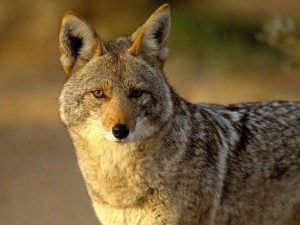- Coyote Pedagogy is a term sometimes used to describe King’s writing strategies (Margery Fee and Jane Flick). Discuss yourunderstanding of the role of Coyote in the novel.
In their article, Fee and Flick suggest that Thomas King’s Green Grass, Running Water is a story dominated by the Coyote Pedagogy. To explain this terminology, Fee and Flick refer to the imagery of borders. Borders, according to their article, are “constructed by what you know and don’t know” (131). And in this way, borders are used to segregate different ways of knowing (131).

Photo Credit: Shevlin, Ron. “The Great Divide”. 2014. Web.
As humans, we are apt to create borders, to separate the world into categories. In The Truth About Stories, King speaks to this kind of binary thinking. And King suggests that categorizing limits our ability to really understand the world (and each other) (21).
Through his Green Grass, Running Water, King, “protest[s] the sterotyping of Native peoples” through categorization, “and repeatedly call[s] to public attention Canada’s history of destroying, not preserving, [I]ndigenous cultures” (Frye xvii). However, he accomplishes this without lecturing to the readers. Instead, his literature weaves together stories in a way that invites the kind of curiosity and wonder that cause us to cross borders and question categories.
King’s novel features Coyote: a character who invites the reader into a journey of discovery, in the same way that the allusive coyote has invited the curiosity and wonder of biologists and researchers throughout North America.

Photo Credit: Schoemer, Mike. “Coyote Sighting”. 29 Sept. 2015. Web.
As animals, coyotes are characterized as one of the top three most adaptable mammals, second to only rats and humans (Redel). In fact, as this CBC Ideas episode suggests, “[d]espite mass poisonings and eradication campaigns, despite hunting and hatred and persecution, North America’s great Trickster, Old Man Coyote still lives and prospers” (Redel). As this quote illustrates, this CBC podcast tells an interweaving tale of the lives of “biological” coyotes and the infamous Coyote. The interesting point to note is that in both cases, these creatures are characterized in the same way: as adaptable, intelligent, resilient, and allusive. As Redel suggests, coyotes have had to adapt in order to accommodate changes in their habitat and food supply as well as increased threats from human intervention.
The symbolic significance of the similarities between coyotes and Coyote would not have been lost on King. Through Coyote, King complicates and unravels the reader’s way of knowing as Coyote consistently crosses diverse political, disciplinary, literary, and cultural borders (132). In this way, Coyote invites the readers to enter into a world of uncertainty, a world without categories. Coyote’s character “entice[s]” and “even trick[s] the audience into finding out for themselves [. . .] the edge of the expected, the edge of the known” (Fee and Flick 132).

Photo Credit: Gonzalez, Jamie. “Stepping Into the Unknown”. 14 Jun. 2014. Web.
King confirms that this was his intent through an interview conducted by the CBC. In it he states that Coyote was written to represent both the “chaos and harmony” of the real world.
In the story, Coyote is able to go anywhere and do almost anything. Coyote is relatable to the reader through his personality. He is curious, (overly) confident, defensive (at times), distractible, optimistic, eager, and inventive. Coyote’s character invites the reader into a world of imagination where humour and seriousness exist together; where historical allusion and popular fiction both come to life.
My question to you is this:
As we look at the similarities between coyotes and Coyote, we see creatures who are able to navigate uncertainty and hostility with adaptability and resilience. In a way, it would seem that the c/Coyote is an ideal representation of Canada’s Indigenous people. The more I learn about colonialism and its effects on our First Peoples, the more I see patterns of resilience and adaptability. I wonder if by understanding more of our history, whether our eyes will be opened to the amazing resilience and strength of our Indigenous peoples. I wonder if this new perspective will help to foster respect, honour, and awe rather than feelings of pity or guilt. I wonder if, in the words of Jon Slan, stories like this can give us the “courage to confront the present without distaste, the past without nostalgia, and the future without fear” (qtd. in Frye xx).
Works Cited
Fee, Margery, and Jane Flick. “Coyote pedagogy: knowing where the borders are in Thomas King’s Green Grass, Running Water.” Canadian Literature, 161 (1999): 131-139. Web.
Frye, Northrop. The Bush Garden: Essays on Canadian Imagination. Concord: Anansi Press. 1995. Print.
King, Thomas. Green Grass, Running Water. Toronto: Harper Collins. 2007. Print.
King, Thomas. The Truth About Stories: A Native Narrative. Toronto: Anansi Press. 2003. Print.
Newman, Kevin and Tina Srebotnjak. “Green Grass, Running Water Author Thomas King on Using Comedy.” CBC Digital Archives. CBC. 7 Apr. 1993. Web.
Redel, Dave. “Coyotl’s Song.” Ideas. CBC. 13 Jul. 2016. Web.
Selected Examples of Coyote’s Characteristics
Unconcerned: “Everything’s under control” (2); “Take it easy [. . .] Sit down. Relax. Watch some television” (3)
Curious: “Where do Coyotes live? [. . .] And Sky Coyotes?” (38); “Wait, wait, wait [. . .] who are those other people walking out the gate with Lone Ranger?” (100)
Defensive: “It’s not my fault [. . .] I believe I was in Toronto” (68); “Ah, excuse me [. . .] I was asleep at the time” (70); “That really wasn’t my fault” (274); “I didn’t do anything…I just sang a little” (416)
Sees himself as ‘special’/Outside the rules: “It’s [bestiality’s] against the rules.” [. . .] “But he doesn’t mean Coyotes” (146).
Distracted: “Is that the end of the story? [. . .] “I don’t care much for November” [. . .] “Forget November [. . .] Pay attention.” (195)
Doesn’t listen well
“Forget being helpful…Sit down and listen” (229)
Busybody (266)
sandrawu
July 19, 2016 — 11:13 pm
Hi Janine,
Great post! I’m glad you brought up the topic of binary thinking, because I wrote a previous post on it as well, and the more I ponder about how and why humans like to use this extreme all or nothing, black/white, right/wrong theory to explain for everything, the more I think it’s because we’re so driven by our egos that we become too weak to admit our weaknesses and faults. We can’t bear the thought that there are things we don’t understand, and therefore we choose to continue being ignorant and uneducated. I think we tend to take the things we don’t know, concepts that are unfamiliar/strange/new, cultures and beliefs that differ from ours, and condemn it to feel as though the power is still within our hands. What do you think?
Cheers,
Sandra
janine fleming
July 21, 2016 — 7:26 pm
Hi Sandra,
I think you’re onto something here. Binary thinking is so much easier, and therefore, we humans naturally gravitate towards this form of thinking. It allows us to accept things that fit with our assumptions and beliefs, and compartmentalize or throw out things that do not. A dogmatic belief system, while harmful to others, simplifies our decisions. The kind of thinking that allows for areas of gray makes life messy. It complicates our decisions and results in ambiguity and uncertainty. A “gray” life is not an easy life. However, it is a life that values human relationship over individual comfort.
In listening to some recent podcasts by the CBC and TED Radio hour, I have been reminded of how our individual thinking has done so much damage to our society. It allows us to refuse to listen to others and focus our decisions only on what is best for ourselves. The kind of thinking that King and Chamberlin espouse invites a more collective and co-operative approach to decision making. It invites a collective mindset, the kind that does not allow for binary thinking.
I wonder what it would take for Canadian society and politics to make a shift towards this way of living. (In saying this, I’m not suggesting that we cannot have strongly held beliefs…I’m just suggesting that when we hold these beliefs too tightly, we might miss out on the truth that is revealed through listening to other perspectives and accepting that the world is messy).
What are your thoughts?
Janine
chartils
July 20, 2016 — 9:35 pm
I like that you brought human curiosity into your discussion on categories. I feel like curiosity is what leads a lot of people’s knowledge and therefore by leading readers curiosity across borders that are present in the popular imagination, King is able to blur the borders and encourage readers to keep the borders ambiguous if not completely gone. This is furthered by his inclusion of the reader by constantly keeping a dialogue going between Coyote and the ambiguous “I”.
I’m curious to hear your thoughts on the part of the novel where Coyote becomes a part of the ‘real’ world. How does your speculations on the perspective that results in viewing Native peoples come into play in the realism aspect of the novel? More specifically, in the plot of the characters of Blossom who are modern Natives living in a contemporary Canada and affected by a history of a lack of perspective.
janine fleming
July 21, 2016 — 7:37 pm
Hi Charlotte (?) — I’m assuming Chartils is a screen name?
Thanks for your insights and your question!
I think what King does by bringing Coyote into the “real world” of the novel is introduce us to what it is to practically (and not just intellectually) cross borders.
Coyote is the embodiment of Indigenous story-telling and his interactions in the real world illustrate how Indigenous stories and ways of knowing can be integrated into the world as the reader knows it. I think this was a clever move by King. First introducing us to Coyote as a narrator or figure exterior to the “real world”, and then allowing him to be present within the “real world”. This shift forces the reader to consider that perhaps holding the two worlds as separate entities from one another is not the most appropriate approach.
What King does through Coyote is offer a “real life” example of border crossing. Coyote shows us how messy this can be, how uncertain, how unstable. But Coyote also shows us how beautiful this process can be.
Coyote invites us into the mess of the gray area in between–the no-man’s-land between black and white–between knowing and not knowing. Coyote is an example for us to follow. He gives us the freedom to make mistakes, to take chances, to seek answers, to feel deeply, to connect with others.
Hope that makes sense.
Feel free to write back!
Janine
chartils
July 21, 2016 — 9:29 pm
That was really well put! Thanks for your thoughts. Coyote being an ambiguous character in order to allow imperfections and freedom is a really great point and one that I think could be explored further.
Thanks!
Charlie
Samantha Smirfitt
July 22, 2016 — 8:15 pm
Hello Janine!
I enjoyed the distinction between coyote and Coyote. I liked how you brought up binary thinking. Especially when you write: “through Coyote, King complicates and unravels the reader’s way of knowing as Coyote consistently crosses diverse political, disciplinary, literary, and cultural borders.” Coyote is a character who blurs the lines between worlds and as you point out, binaries. I think that Coyote is a great example of the learning that can occur once you break out of binary thinking. Coyote’s enthusiasm for learning and crossing borders is what makes them such an interesting character.
As for your question… I’m not quite sure what you’re asking. If you’re asking if I agree with you, I definitely do. I think that through learning about the history – the raw and real experiences of Indigenous Peoples instead of sugar-coating them to the degree that they are – Canadians and non-Indigenous Peoples will develop a new perspective. Personally, my perspective and opinions of Indigenous Peoples has changed significantly the more educated I become on these issues.
Thanks for your post 🙂
janine fleming
July 25, 2016 — 9:44 am
Hi Samantha,
Thank you for your comment. I appreciate that you took the time to read my blog and highlight some of the key points I was trying to make.
The question at the end was more of a reflection, I suppose. Just musings on how characters, like Coyote, show us the power of overcoming binaries. I completely agree that the more we learn about others, the more we open ourselves to new possibilities and new ways of thinking. I believe that this is one of the most important ways to move towards reconciliation and foster peace.
Janine